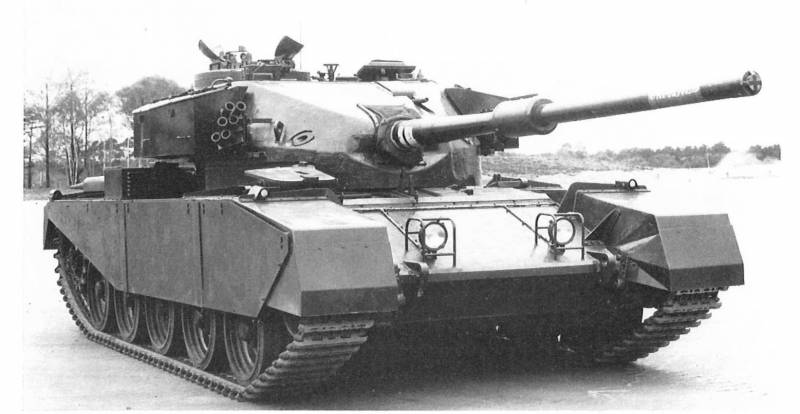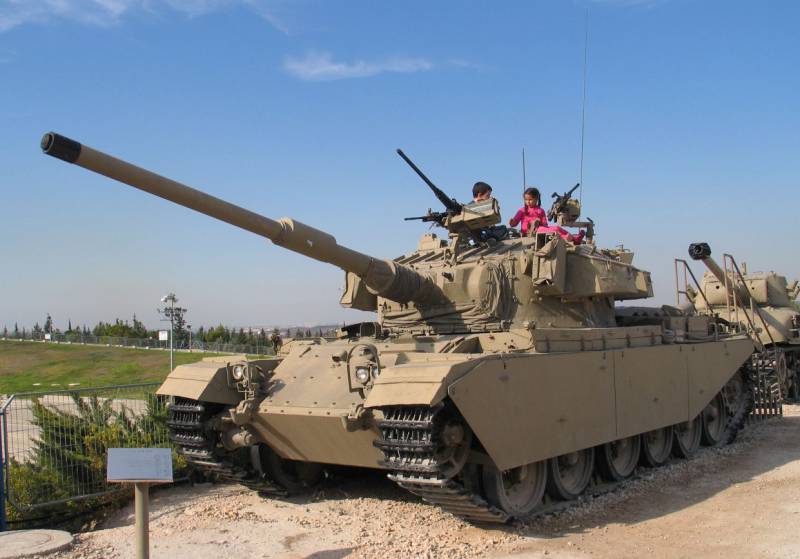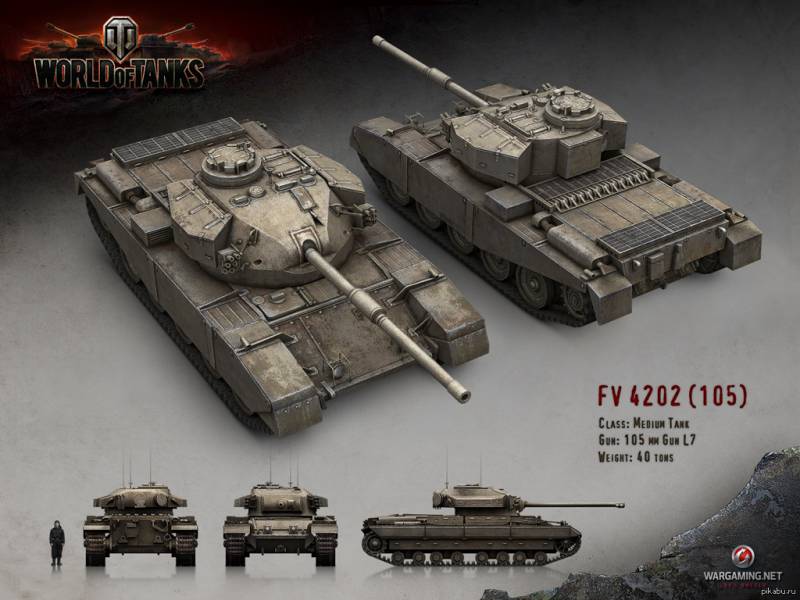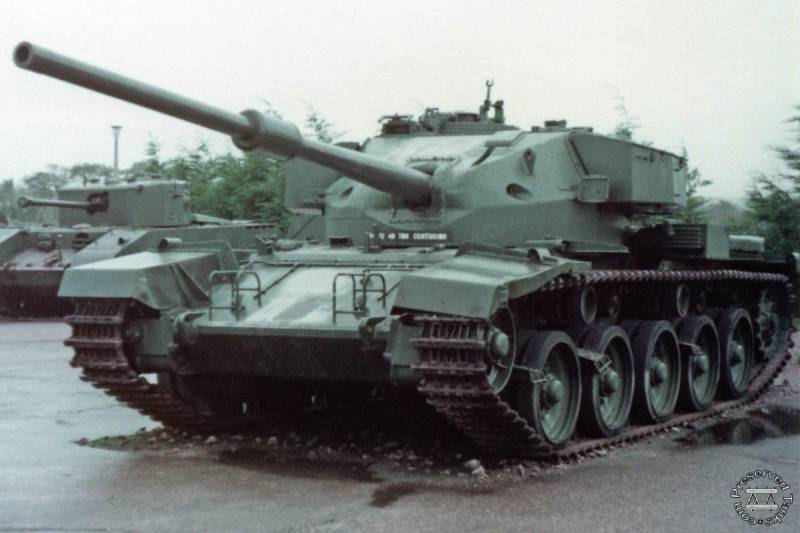British medium tank FV4202 (draft)
Speaking of British tank building, it should be noted that during the years of World War II it was far from leading roles. The first tank that could be called a breakthrough was the Cromwell, designed by the British in the 1941-1943 years. This tank was armed with 57-mm or 75-mm guns, and thanks to the installation on it of an aircraft engine, the Meteor could become the most high-speed British tank of that time period. “Cromwell” could not be called a bad tank, but in 1943, on the battlefield, he had to compete with the German “Tigers” and “Panthers”. Against these formidable "predators" the 75-mm cannon "Cromwell" was no longer enough, and a more powerful tool on it could not be installed due to the small size of the tower and the tower shoulder strap.
A more powerful weapon was installed only on the Cromwell’s successor, the Comet cruiser tank. “Komet”, thanks to a larger-width tower with a developed feed niche, allowed the designers to install a new 77-mm gun. An armor-piercing projectile fired from this weapon accelerated to 787 m / s. One can rightly say that it was the most powerful cruising tank of Great Britain during the Second World War. In fact, this combat vehicle was inferior to the German "Panther", but it was significantly superior to the most massive German tank - Pz IV.
At the same time, the cruiser tank, which was called the “English Panther,” entered service with the British army after the end of the war in Europe. This tank became Centurion. This tank had a welded hull with rational angles of armor. At the same time, the combat vehicle was armed with 17- or 20-pounders and remained in service with the British army until the 1970s. Late versions of this tank (from about the middle of the 1950-ies) were armed with a rifled 105-mm L7 gun.
It is worth noting that by the middle of the 1950-s tank builders around the world realized that the current generation of tanks had reached its final. The military needed something revolutionary, new. For this reason, the 50s of the 20th century, in particular their second half, became a time when the most diverse, including bold, ideas were implemented in the field of tank building. Homeland tanks, the UK, was no exception to the general trends.
In the UK, an experimental medium tank FV4202 was created on the basis of the Centurion tank, which, by reducing the linear dimensions of the hull, won in mass and, as a result, in dynamics, it was also armed with an 105-mm gun. An interesting feature of this tank was the “recumbent” location of the mechanical input. However, he never went into the series, since by that time the concept of creating the main battle tank was already well developed. And the British themselves, with 1945, decided to abandon the division of tanks into cruising and infantry.
It should be noted that the experimental tank FV4202 largely became the basis for the future of the main battle tank Chieftain. The development and research on this project was initiated by the British at the beginning of the 1950-s, two prototypes were considered to assess the specific technical capabilities of the tank. One of them and the most significant was the 40-ton version of the Centurion tank, known as FV4202, which had a reclining position for a mechanical drive and the installation of a gun without an external shield - a mantlet-less tower. The semi-lying position of the driver was foreseen by the tank designers in order to reduce the overall height of the combat vehicle. The second solution was designed to make the gun less vulnerable.
A well-known expert in the field of tank design, Yuri Pasholok, called the FV4202 tank the “younger brother” of the Centurion. This tank, which was the result of the labor of British engineers in the years of the Second World War, seemed to go to the end of its development in the 1950-s. At that time, before the designers opened three main ways. The first of them involved the development of a principled new combat vehicle, the second - a deep modernization of the existing tank, the third - an evolutionary path of development. Initially, the third variant of the development of the situation was considered by engineers as the least promising, but ultimately this path was chosen - the path of evolutionary development.
The appearance of the beautiful 105-mm L7 gun in England and the installation of an additional reservation on the tank extended its service for decades, and in some countries of the world the Centurion still carries combat service. And this is a tank, a prototype of which was built in the UK back in 1945 year. The product of its deep modernization was the tank Centurion Action X, which appeared in 1955 year. This tank appeared by installing a fundamentally new turret on the chassis of the Centurion Mk.7 tank, but it didn’t go further experiments with this tank.
If we talk about the creation of a fundamentally new tank, then the first steps in this direction were taken by the British in the 1956 year. It was this year that the tank, known as the 40-tonne Centurion, came to the test. It is worth noting that we are talking about the unofficial nickname of the combat vehicle, better known under the symbol FV4202. Tank development Leyland Motors bypassed rival Medium Gun Tank FV4201, which forever remained only in the form of a layout. The metal-made tank FV4202 was an evolutionary development of the ideas that were laid in the British tanks Centurion and Centurion Action X.
The hull of the new tank was the development of the Centurion hull, but it turned out somewhat lower. This reduced the overall height of the FV4202 tank, which was only 2,75 m. It was 25 centimeters lower than the height of the Centurion tank. Reducing the height of the hull of the tank was used by designers to reduce the angle of inclination of the front sheet. Also, the hull was made almost half a meter shorter, this decision made it possible to reduce the number of road wheels to 5 per side. Thanks to all the operations carried out on the tank, his weight was reduced from 51 to 40 tons.
The FV4202 tank turret was also an evolutionary development, but now it was a Centurion Action X tank. The front part of the turret reminded quite a lot of its predecessor, but there were also new solutions, for example, a “beard” under a gun mount. The two tanks had a lot in common in the design of the roof of the tower. Noticeable differences could be considered only in the stern. As the main armament on the tank used 20-pound gun later modifications. By that time, she had already got rid of the massive knob, having got an ejector instead. Outwardly, this gun very much resembled the 105-mm L7 cannon - to many ordinary people, the appearance of the FV4202 tank gun is misleading.
In total in the UK collected three prototypes of the tank FV4202. Testing these combat vehicles went for several years, however, the 40-ton tank and did not give a chance to start mass production. The idea of an evolutionary development of the concept of the tank Centurion was nevertheless abandoned, instead the concept of the tank FV4201 was further developed. Already in September, the prototype P1959, which became the ancestor of the whole Chieftain family of tanks, was sent to 1 for testing. Today, no one can say how the British tank building would develop further if the British adopted the FV4202 tank, which weighed significantly less than the Centurion, while possessing comparable weaponry and level of body armor.
Despite the general similarity with the hull of the tank Centurion, the body of the FV4202 had a lot of differences. First of all, the new British tank differed from its progenitor in a lower hull, which was especially noticeable in the bow. Reducing the height of the hull of the tank allowed designers to remake the front sheets, significantly reducing the angles of inclination. Due to this, with the same thickness of frontal armor, the body of the tank FV4202 turned out to be more protected. However, 80 mm armor in the second half of the 1950-s, even with significant tilt angles, was clearly not enough. Like the Centurion tank, the mechvod was located on the right side while moving. Reducing the height of the hull did not increase comfort, however, on the tank Chieftain the driver was almost lying. In general, on the FV4202 tank his working conditions were more or less comfortable. At the same time, unlike the Centurion tank, which used a double hinged hatch of a driver, a hatch was implemented on the FV4202 tank, which was lifted up and retracted to the side. This solution was better and more convenient.
The chassis of the new tank almost without changes migrated from the serial tank Centurion Mk.5. But here there were a number of nuances. First, the number of track rollers was reduced to 5, and in this connection, the suspension of the first track roller had to be redone. Secondly, the width of the track has decreased. On the medium tank FV4202 was used suspension system Hortsmana. With various changes, it was used on British tanks starting in the 1922 year. The last time she was installed on the tank Chieftain. Despite frankly a conservative approach, the British completely suited this suspension. However, the answer to the question of how to dismantle such a cart in combat conditions remains open. One of the features of the British tanks and FV4202 in particular is the minimalism of the bottom structure. In the bottom of the tank, there were no escape hatches, only a few service hatches. In case of defeat of the tank, the crew would have to leave it under fire from the enemy.
It is curious that on the basis of the main battle tank “Chieftain” in 1971, the BRV FV4202 was created, the serial production of which began in the 1974 year. In addition to the evacuation machine in 1971, the FV4205 bridge deck was created on the basis of the tank, the serial production of which began in the 1975 year. Although the FV4202 medium tank was forever only a prototype, its name was saved in stories. And with the advent of World of Tanks, more people met him.
The post-war English medium tank FV4202 never became a production model, its production was limited to a series of only three cars. One of these tanks was later allowed to be scrap, the second was converted into a repair and recovery vehicle, and the third remained to this day, becoming an exhibit of the tank museum in Bovington. Today this English museum houses more than 300 tanks representing the 30 countries of the world. In this case, the tank is not in the best condition. The time and the unfavorable climate for the equipment (the tank was stored for a long time under the open sky) did their job: the tank needs serious restoration.
Information sources:
http://warspot.ru/4198-mladshiy-brat-tsenturiona
http://wiki.wargaming.net/ru/Tank:GB70_N_FV4202_105/История
http://worldoftanks.ru/ru/content/history/tank-construction/british-tank-construction_part_2
Open source materials




Information